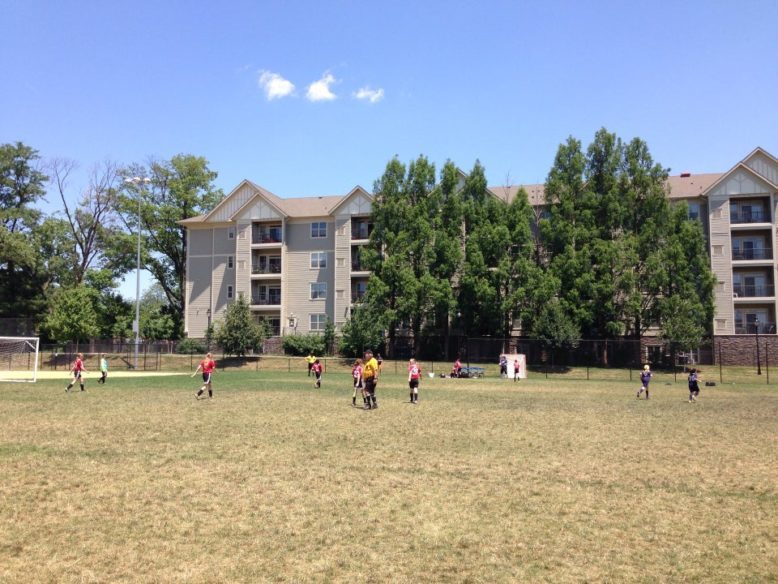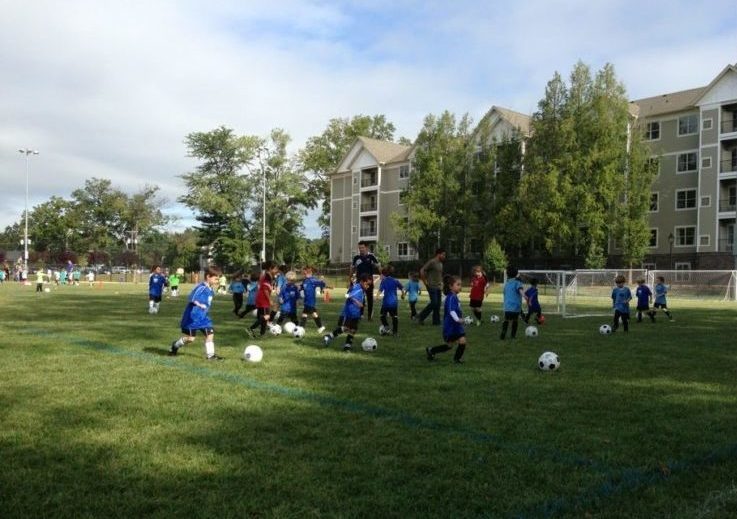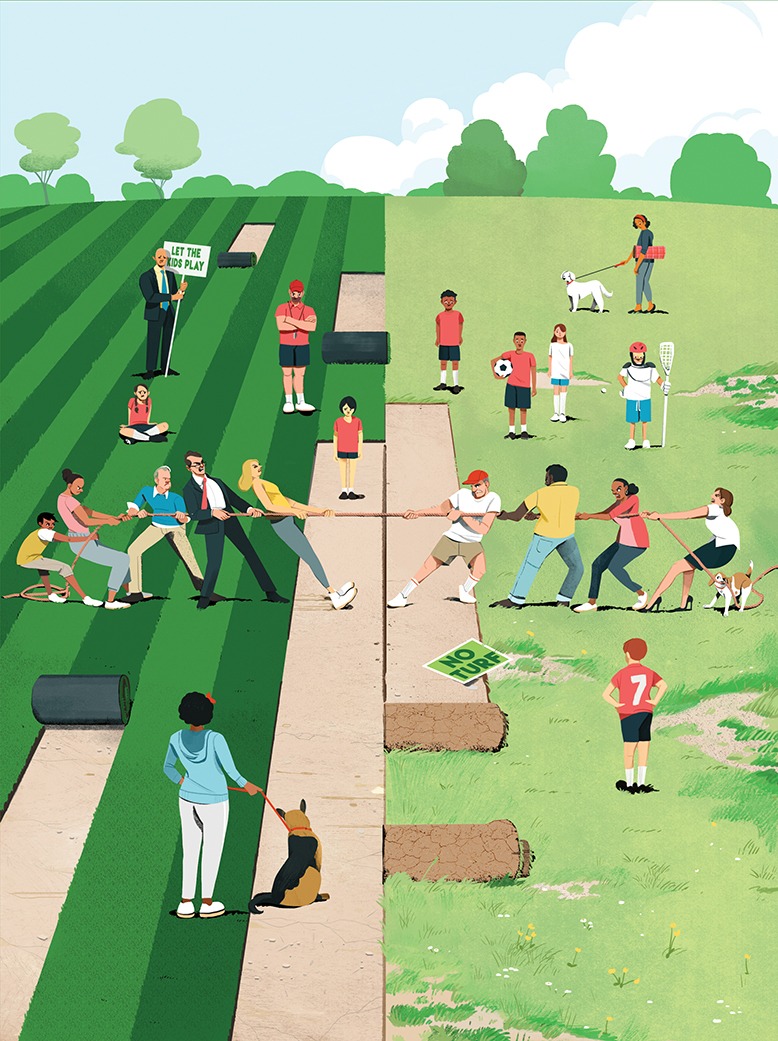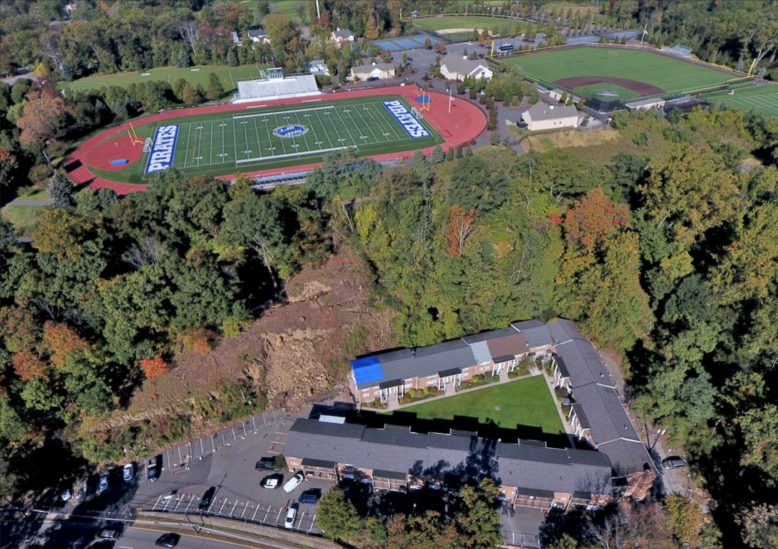
After nearly a decade of living in Maplewood, Frank McGehee was taken aback by the discord that occurred in his town last election cycle.
McGehee, who was mayor at the time, watched as constituents bickered on social media and uprooted each other’s lawn signs. This combative behavior was unusual in the Democratic stronghold, where people typically agree on major issues. The cause of conflict here? An artificial turf field proposal.
The question of turf isn’t exclusive to Maplewood, having created controversy in Westfield, Princeton, Millburn, Holmdel, Belmar, Glen Rock, East Orange, West Orange and numerous other towns. For pro-turfers, the main concern is field accessibility and quality with regard to youth sports, while anti-turfers worry about health, environmental and social justice factors.
McGehee, who supported turf, calls the fake-grass debate “one of the most divisive issues that I’ve ever experienced.” And the not-so-distant past is not lost on him. “With everything happening in the last couple years, from the pandemic to the Black Lives Matter movement, it’s ironic that this issue became the issue,” says McGehee, whose one-year mayoral term ended shortly after the November election, in accordance with Maplewood’s township-government model. Dean Dafis, the new mayor, was also in favor of turf last election cycle.
Strife sparked last summer after a 4-1 vote of Maplewood’s Township Committee approved turfing the athletic fields at DeHart Park, which is located in Maplewood’s Hilton neighborhood and is used by school and recreational teams. The decision was met with mixed reaction in the town and neighboring South Orange, which shares a public school system and some services with Maplewood, including the use of public fields. More than 1,000 residents signed a petition demanding the project be put to a public vote. Grass won out; 54.86 percent of voters were against the turf project. Last November was the second time in 13 years that Maplewood voters rejected turfing DeHart Park, where poor natural-grass fields often disrupt sports schedules, especially after inclement weather.
“I think people understand that something needs to be done,” says Nancy Adams, the only member of Maplewood’s Township Committee who supported keeping and improving DeHart’s grass fields. “Kids, adults, they need a reliable field that is not going to be closed every rainfall,” adds Carol Fardin, a pro-turf resident. That much, most can agree on.

In Maplewood, pro-turfers want to make sure their kids have a reliable place to play. Meanwhile, anti-turfers worry about the community’s health, the environment and social justice issues. Photo courtesy of Tom Sauer
Field Accessibility and Quality
“For us, it’s a simple factor: supply and demand. Our town has gotten younger and younger as the years go by,” McGehee tells New Jersey Monthly. The former mayor, who remains on Maplewood’s Township Committee, added that Maplewood’s limited field space is not meeting the ever-growing needs of organized sports. Hence, the pro-turfers’ catchphrase: “Let the kids play.”
Turf advocates view synthetic grass at DeHart as a smart solution, particularly for sports such as soccer and lacrosse. Turf fields can accommodate multiple sports, and they’re considered more predictable, reliable and manageable when it comes to maintenance and weather. Artificial fields drain quickly, and there’s no mud to worry about. The surfaces of turf fields are fairly consistent when built and maintained properly, whereas grass fields are more susceptible to unevenness, bumps and divots. Pro-turfers also say that their preferred field withstands everyday wear and tear better.

Illustration by Nathan Hackett
“The amount of manpower and materials used to maintain the grass fields was counterproductive because it wasn’t draining properly,” Fardin says of DeHart. However, anti-turfers say that DeHart’s grass fields were not properly constructed nor maintained over the years.
At press time, McGehee said Maplewood’s head engineer and the Department of Public Works were collaborating on an assessment and recommendations for how to best maintain DeHart’s grass fields moving forward.
“The history of that field, and the fact that it devolved, is because of human error and bad choices from officials and the Department of Public Works,” says Emily Konopinski, a Maplewood resident against turf. “They just literally want to put a blanket over the problem and be done with it.”
Adds Anthony Q. Artis, who can hop his backyard fence and be in DeHart: “I don’t know anything about park management or maintenance, but I know that plenty of fields exist that are not artificial turf that have been there for years and years, and they’re doing just fine.”
Injuries and Health
When the New York Yankees play at turf stadiums, such as Tampa Bay’s Tropicana Field, it is not unusual for star slugger Aaron Judge to receive a day or two off during such a series. The team considers it a proactive measure, as the surface is harder than grass and can be tough on the body, and Judge has a history of injuries. New York Giants safety and former Rutgers star Logan Ryan, meanwhile, blamed artificial turf when teammate and East Orange native Jabrill Peppers ruptured his ACL in October. The Giants and Jets’ home, MetLife Stadium in East Rutherford, is turf, as are many other NFL venues.
“We’ve really got to talk about these turf fields, man,” Ryan said during a press conference last October. “It’s just not best for a player’s safety. It’s too many lower-body injuries, and it’s unfortunate.”
Guarding against sports injuries is not the only health concern involved in this debate. Anti-turf residents in Maplewood reached out to the Children’s Environmental Health Center of the Icahn School of Medicine at Mount Sinai, which had previously reviewed the effects of artificial turf. In June 2021, the center sent a letter to McGehee and Maplewood’s township committee that “strongly discourage[d] the installation of artificial turf fields in Maplewood Township due to the uncertainties surrounding the safety of these products.”
Citing its review, Mount Sinai’s letter claimed “children and young adults are uniquely vulnerable to harmful exposures from artificial turf surfaces.” Turf fields can become extremely hot, thus creating risk of burns, dehydration and heat stroke, the letter says. Many of these artificial surfaces use recycled tire infill, or crumb rubber, which contains carcinogens and neurotoxins that can be inhaled, ingested and transported via clothing or equipment.
“That was pretty interesting,” Konopinski says of the Mount Sinai letter. “It was also pretty wild to see how people were really willing to discard information like that in an effort to just kind of push forward the agenda for the turf.”
However, a partial July 2019 report from the United States Environmental Protection Agency found that, “while chemicals are present as expected in the tire crumb rubber, human exposure appears to be limited based on what is released into air…” The report, initiated in 2016 during the Obama administration, is not a risk assessment. The release of the report’s second part, which delves into the potential health risks of chemical exposure, was postponed due to the pandemic.
The Environment
Due to the toxins that have been found in turf infill, runoff from heavy rain and flooding is a concern for the environmentally conscious. Turf surfaces are impervious compared to natural grass, which means inclement weather can transport the infill into the natural environment and local water supplies.
Many turf fields feature detention basins to capture infill, but runoff can create larger problems. Two months before Maplewood voted on the DeHart referendum, Hurricane Ida hit the area. A rockslide in nearby West Orange ultimately displaced 45 families after it was determined that the Ron Jolyn apartment complex had to be demolished. The apartments are downhill from Seton Hall Prep’s Kelly Athletic Complex, a turf facility that required the removal of 1,000 trees before construction began in 2014. Some former tenants blame the impervious surfaces and eliminated forest for the rockslide, as there was nothing to impede the deluge.
“That rock wall would not be in the shape that it’s in if they didn’t remove all of those trees,” claims Christine Catalano, one of the West Orange evacuees. A Ron Jolyn resident since 1995, she adds that flooding became a constant problem at the apartments after Seton Hall Prep broke ground on the athletic complex.
Seton Hall Prep declined to comment for this article. New Jersey Monthly reached out to the township attorney for West Orange for comment, but was unable to reach him.

A rockslide at an apartment complex downhill from Seton Hall Prep’s turf facility displaced families after Hurricane Ida. Some evacuees wondered if turf led to excessive runoff. Photo courtesy of Andre Malok/The Patriot-News Advance Local Media
Pro-turfers, however, argue that turf can be environmentally friendly. Fardin notes that grass fields may require the use of chemical fertilizers and pesticides, which can also be displaced, and that upkeep requires lots of water. Turf companies now market organic, nontoxic infills, as well as cooling systems. Like any technology, McGehee says, “it’s constantly evolving and improving.”
However, some Maplewood residents, like architect Camilla Flannery, remain skeptical. “They’re businesses, and they’re marketing their products. You’re getting science from a marketing perspective, and that science is always twisted,” she claims.
Social Justice
Maplewood’s pro-turfers took issue when Konopinski, a longtime resident, publicly referred to their efforts as “modern colonialism.” Speaking to New Jersey Monthly, the Air Force veteran admits that “may be hyperbolic.” However, Konopinski does not back down from her assertion that pro-turfers are less sensitive to the issue because many of them don’t live in the Hilton neighborhood.
She characterizes pro-turfers this way: “It’s like: ‘This is what I want, and it happens to be in this neighborhood, and I’m going to go get it and take it, because my kids need to have a place to play soccer.’” Her response to that? “Well, yes, your kids need a place to play soccer, but other people need to have a place that is also there for many other reasons.”
That raises the matter of green space, an environmental concern that overlaps with social justice issues in the eyes of anti-turfers.
DeHart Park is the only public green space that serves Maplewood’s Hilton neighborhood, as well as the adjacent Lightning Brook neighborhood. Compared to the rest of the town, these areas are “predominantly lower income and communities of color,” Flannery says. Adams, of Maplewood’s Township Committee, adds that the area surrounding DeHart is more densely populated and features homes on smaller lots with less spacious yards.
Anti-turfers frequently point out that Maplewood’s wealthier residents—farther from DeHart and closer to the abundantly green South Mountain Reservation—overwhelmingly voted in favor of converting the field to turf. “The closer you got to the park, the more ‘no turf’ signs there were,” Artis says. “The farther you got away from [DeHart], the more ‘pro-turf’ signs there were.”
“The people of the Hilton neighborhood, whom it would be directly impacting, were saying, ‘We don’t want it,’” adds Konopinski, who brings up recent debates in the South Orange-Maplewood school district over allegations of segregation. “How can the other side of town, a predominantly white group with means, look at [removing green space] and think it’s okay to just dismiss [the Hilton neighborhood’s] opinion?”
McGehee and Fardin counter that DeHart was designed, first and foremost, to be a sports complex. It is one of the few public parks in Maplewood with lighting, allowing athletic schedules to expand into the evening.
Moving Forward
The temperature in Maplewood has cooled since the November vote, but the conversation has continued.
Shortly after the election, McGehee opened an athletic-field/green space task force to Maplewood and South Orange residents on both sides of the turf debate.
“The most important part is everyone is talking. Both sides have come together in the best interest of the community at large,” Mayor Dafis says. “We’ve all left what happened in November behind us, hopefully.”
Dafis says that expanding Maplewood’s recreational shared services with South Orange, entirely resodding DeHart, and collaborating more with school, club and rec teams on scheduling are all ideas the task force is looking into.
One compromise shared by pro- and anti-turfers: Build an indoor turf space, which would provide year-round play, minimize environmental damage, spare DeHart’s green space, and eliminate game cancellations.
Grappling with compromises and restrictions to manage artificial-turf projects is a growing dilemma for Garden State municipalities. In 2017, Belmar banned residents from installing artificial front yards and imposed similar restrictions on business, commercial and professional zones. For Princeton, a turf-field project at Hilltop Park was temporarily put on hold in March 2021 after the town’s Environmental Commission did not recommend the use of synthetic turf. East Orange, meanwhile, pushed forward with plans to turf its Columbian Park in September 2021, despite environmental and social justice concerns from members of the community.
The topic of turf fields not only ignited debates in Holmdel, but it also led to a township investigation and a lawsuit, and contributed to a mayor losing his seat, before funding was approved for turf at William R. Satz Middle School this past December.
Back in Maplewood, “we’re not dealing with turf or non-turf,” McGehee now says. “We’re focusing on our fields and accessibility for our young people and our community.”
The task force was a welcome step, as some anti-turfers feel the DeHart proposal was rushed and that there was a lack of community engagement prior to the election. “Perhaps our process before was myopic and not as transparent or as collaborative as it could have been,” Mayor Dafis concurs.
What Maplewood does have now is more understanding. Dafis acknowledges the validity of anti-turfers’ concerns, particularly when it comes to the social justice aspect. Hilton resident Artis said it wasn’t until Election Day that he had a productive dialogue with someone on the other side. He was with fellow anti-turfers making their voices heard at the ballot box while a group of pro-turfers were doing the same. Artis and a pro-turfer not only got to talking, but to listening.
“I told the guy, ‘If somebody had said some of the things you said beforehand, this might have been something that could have been a reasonable conversation,’” Artis recalls. “But there was never a conversation.”
“You have to read your room,” McGehee says now. Adds Dafis: “If this is about how Maplewood can inform other communities, I would say, have a task force and have public engagement at the very outset. Bring everyone to the table. Allow people to speak freely and openly, and do that until you feel you’ve gotten as much feedback as you can from the community at large, and certainly from the people who live around any particular field where you’re intending to do this.”



